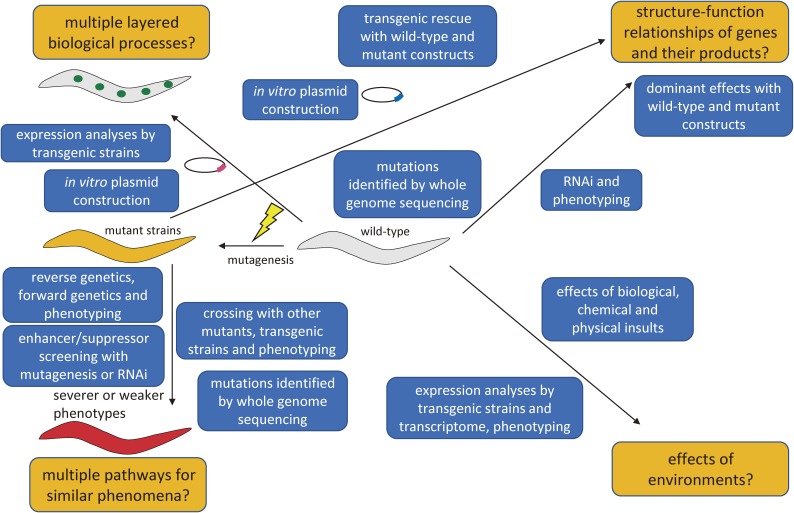Figure 1.
A schematic diagram showing questions to be addressed by functional genomics of C. elegans. Examples of important questions to be addressed by genetical analyses are indicated by orange boxes, whereas methods to solve the questions are indicated by blue boxes. Representative questions are originated by multiple layered biological processes, multiple pathways for similar phenomena, structure-function relationships of genes and their products, and effects of environments. Multiple layered biological processes mean that organisms have multiple layered regulations of causal relationships with molecular-, cellular-, tissue- and whole body-levels. Also, organisms have spatio-temporal regulations. Complicated mechanisms are unraveled, for example, by examining transgenic analyses mentioned in the text. Multiple pathways for similar phenomena mean that organisms have often multiple independent causes for seemingly similar phenotypes and these are categorized and unraveled by crossing with other strains (as epistatic analyses) and isolation of enhancers and suppressors to identify genetic interactions. Effects of environments are important subjects because gene regulations are essential for adaptation to the environment an organism is exposed. Explanation of blue boxes are followings. The phrase “expression analyses by transgenic strains” indicates that transgenic strains can be generated by injecting plasmids into the germline of the animals. The phrase “in vitro plasmid construction” means that researchers can generate varieties of plasmids with current molecular biological methods. The phrase “reverse genetics, forward genetics and phenotyping” means that researchers can isolate new mutants only by sequences and only by the inspection of phenotypes of interest as “reverse genetics” and “forward genetics”, respectively. The phrase “enhancer/suppressor screening with mutagenesis or RNAi” means that researchers screen for new mutants (or RNAi clones) which aggravate (enhancer) or attenuate (suppressor) the phenotypes of parent mutants. The phrase “crossing with other mutants, transgenic strains and phenotyping” means that researchers make double mutants etc. to see which phenotype is dominant, to dissect whether two causal genetic variations are interactive with each other. The phrase “mutations identified by whole genome sequencing” means that researchers can identify any types of mutations by analyzing the whole C. elegans genome using the next-generation sequencers and bioinformatics. The phrase “transgenic rescue with wild-type and mutant construct” means that researchers can microinject various plasmids to see whether the sequences can rescue the mutant phenotypes to understand whether some genetic variants retain wild-type function or not. The phrase “dominant effects with wild-type and mutant constructs” means that researchers can know by overexpression or ectopic expression of wild-type or mutant proteins in the wild-type animal background whether they have dominant phenotypes or not. The phrase “effects of biological, chemical and physical insults” means that researchers can expose worms to some biological (for example, bacterial infection), chemical (for example, toxic substances) and physical (for example, hot temperature) and see the effects by phenotypes. The phrase “expression analyses by transgenic strains and transcriptome, phenotyping” means that researchers can use transgenic reporters to see the potential changes of the expression patterns under some environmental changes in addition to the information about when and where the gene products may play roles. Also, researchers can use the worms to analyze RNA expression changes with microarray or RNA sequencing with a next-generation sequencer to find the expression changes under some environmental changes in addition to phenotypes.

